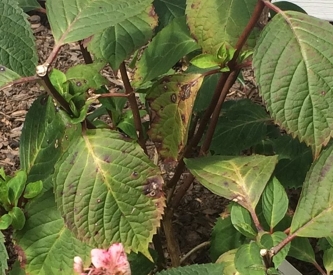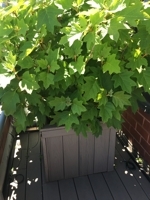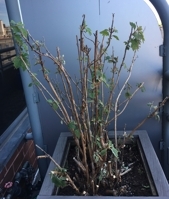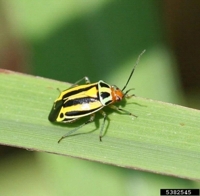Hydrangeas have few serious pest and disease problems that affect their health although there are several listed here that will cause cosmetic damage. For information on the selection, care, and pruning of hydrangea please visit our Hydrangea fact sheet.
Diseases
Botrytis blight (Botrytis cinerea). Small water-soaked spots on the petals quickly expand into brown irregular blotches. Brown, withered masses of flowers may be covered with the fuzzy gray growth of the fungus. Flower buds may also be affected and leaf spots can occur when infected petals have fallen on them. Disease development is favored by cool, humid, wet conditions. The causal fungus survives almost indefinitely in plant debris. Spores are spread to healthy tissue by wind. For prevention, use the methods described below for powdery mildew.

Leaf spots caused by a variety of fungi can occur on hydrangea. A common leaf spot disease in the northeast is caused by the fungus Cercospora. Tan spots with reddish brown borders form on the leaves. Infection can be reduced by minimizing leaf wetness. If needed, protectant fungicides can be applied prior to infection. This may be desirable for hydrangeas that had a lot of leaf spots the previous year and prior to wet weather. In addition, removal of infected leaves during or at the end of the season may help reduce inoculum the following season.
Powdery mildew (Microsphaera penicillata) can occur on all hydrangeas but is most serious on bigleaf hydrangea. In addition to the usual white, powdery fungal growth on the leaf surfaces, yellow or purple leaf blotches might be present. This disease doesn’t usually harm the plant but is aesthetically problematic for some gardeners. The problem will be most severe on plants in shady or crowded sites that promote high humidity. Clean up fallen leaves and dead tissues to remove the spores that may cause new infections. Chemical control is unnecessary except in severe cases. Products available to control powdery include potassium bicarbonate or horticultural oils.
Root rot (Armillaria spp.) can occur in landscape plantings, especially on oakleaf hydrangea (H. quercifolia). Plants stressed by drought or other factors are most susceptible. Symptoms first appear as wilting on one or more shoots. Watering will not return the leaves to normal. Within a few weeks, the remaining shoots will wilt and the hydrangea will die. The fungus produces white, fan-shaped mycelia mats under the bark at or near the soil line. In addition, black, shoestring-like rhizomorphs of Armillaria can usually be found on the surface of infected roots, in the surrounding soil, and under the bark. In the fall after a heavy rain, clusters of honey-colored mushrooms appear above the damaged roots.
Good growing conditions are the best defense against Armillaria root rot. Water during summer droughts and fertilize according to soil test results. There is no chemical control. Another root rot, caused by Phytophthora nicotian, is favored by poorly drained soils. Symptoms are similar to those caused by Armillaria sp. Do not plant hydrangea where flooding occurs after a heavy rain.

Healthy plant

Suspected root rot
Powdery mildew (Microsphaera penicillata) can occur on all hydrangeas but is most serious on bigleaf hydrangea. In addition to the usual white, powdery fungal growth on the leaf surfaces, yellow or purple leaf blotches might be present. This disease doesn’t usually harm the plant but is aesthetically problematic for some gardeners. The problem will be most severe on plants in shady or crowded sites that promote high humidity. Clean up fallen leaves and dead tissues to remove the spores that may cause new infections. Chemical control is unnecessary except in severe cases. Products available to control powdery include potassium bicarbonate or horticultural oils.
Root rot (Armillaria spp.) can occur in landscape plantings, especially on oakleaf hydrangea (H. quercifolia). Plants stressed by drought or other factors are most susceptible. Symptoms first appear as wilting on one or more shoots. Watering will not return the leaves to normal. Within a few weeks, the remaining shoots will wilt and the hydrangea will die. The fungus produces white, fan-shaped mycelia mats under the bark at or near the soil line. In addition, black, shoestring-like rhizomorphs of Armillaria can usually be found on the surface of infected roots, in the surrounding soil, and under the bark. In the fall after a heavy rain, clusters of honey-colored mushrooms appear above the damaged roots.
Good growing conditions are the best defense against Armillaria root rot. Water during summer droughts and fertilize according to soil test results. There is no chemical control. Another root rot, caused by Phytophthora nicotian, is favored by poorly drained soils. Symptoms are similar to those caused by Armillaria sp. Do not plant hydrangea where flooding occurs after a heavy rain.


Other diseases that can affect hydrangea include blister rust (Pucciniastrum hydrangea), bacterial wilt (Pseudomonas solanacearum), viruses, and virescence (caused by a phytoplasma). The blister rust fungus produces masses of orange spores on the underside of the leaves. Blighting of the young leaves and flowers can be caused by the bacterium P. solanacearum, especially after heavy rain during hot weather. Symptoms of viruses include leaf mottling, spots, ring or line patterns, flower color breaking, and distortion. Virescence is characterized by green, stunted flowers or leafy shoots growing from the flower parts.
Insects and Other Pests
Aphids can sometimes build up to high populations on the new growth of hydrangeas. At high numbers, aphid feeding may cause some leaf yellowing or distortion. In addition, aphids excrete a liquid waste high in sugars called honeydew. Sticky, clear honeydew can coat the leaves and other surfaces below the aphids. Sooty mold, a black coating of fungal growth, may form on the honeydew. While these fungi do not directly infect the plant, a lot of sooty mold can block sunlight from the leaves, resulting in decreased photosynthesis. Ants are also attracted to honeydew and some ant species will groom aphids by rubbing their antennae to stimulate honeydew production. They also defend aphids against parasites and predators. To control an aphid infestation, hose them off with a strong spray of water or apply insecticidal soap.
Black vine weevil (Otiorhynchus sulcatus). The larvae of this weevil injure hydrangea by feeding on the roots. After devouring the small roots, the small grubs move on to chew the bark from larger roots, often girdling them. The tops of girdled plants turn yellow then brown, followed by the death of the plant. The adult is 1/2" long, black, with a beaded appearance on the thorax and scattered yellow hairs on the wing covers. Adults are flightless and feed on the leaves at night, leaving notches along the margins. Adults and large larvae overwinter, emerging from May-July. After feeding for 3-4 weeks, egg-laying begins. Insect pathogenic nematodes can be used for control of larvae in the soil. If necessary, chemical control can be used when there is adult feeding and before egg laying starts. The usual timing is during May, June, and July.
The four-lined plant bug (Poecilocapsus lineatus), below left, and the tarnished plant bug (Lygus lineolaris) cause round, brown sunken areas around the feeding puncture wounds (below right). Eggs are laid in soft stem tissue. They hatch around mid-May and the young bugs suck sap from the leaves. They molt five times and mature around the middle of June. Adults are about 1/3" long. The four-lined plant bug is yellow with four lengthwise black stripes on its wings. Leaf spots can become holes. The tarnished plant bug is brown, 1/5" long, with a yellow "Y" shape pattern on its back. There is one generation per year of the four-lined plant bug and two to five generations per year of the tarnished plant bug. Control is not usually necessary for these pests but if needed, use insecticidal soap or ultrafine horticultural oil.
Hydrangea leaftiers (Olethreutes ferriferana also known as Exartema ferriferanum), are quite noticeable when present. While this pest does not have a big impact on the health of the plant, it can reduce the number of flowers. After overwintering in the pupal stage, small brown and white moths emerge in the spring, mate and lay eggs on the tips of hydrangea branches (all types). The newly hatched caterpillars web a few leaves together and feed on the inner (top) surfaces of the leaves and, if present, the flower bud. The webbed together leaves look like little tents and there can be quite a few on a single plant. During the summer, larval feeding is completed and the insect drops to the ground to pupate. There is only one generation per year. If control is desired or needed, the leaves can be pulled gently apart and the caterpillar can be removed and killed. Biological insecticides containing the active ingredient Bacillus thuringiensis kurstaki (Btk) can be used during the caterpillar stage.
Japanese beetles can be a problem on oakleaf hydrangea but seldom bother the other types. Adults are metallic green and consume leaf tissue while leaving behind the veins, resulting in a lacy looking ‘skeleton’ of the leaf. A good way to get rid of these beetles is to knock them off the leaves into a container of soapy water to kill them. Insecticides are also effective but should never be applied during bloom to protect pollinators and other beneficial insects.
Rose chafer (Macrodactylus subspinosus) sometimes feeds on hydrangea and when abundant can injure plants by skeletonizing the leaves. They will also feed on the flower petals, especially of white flowers. Adult rose chafers are slightly more than 1/3" long tan beetles with long spindly legs. They occur in large numbers where soils are sandy. Adults appear around mid-June and feed for about a month to 6 weeks. Females lay 24-36 eggs singly in the ground a few inches beneath the surface. They soon hatch and the grubs feed on the roots of grasses and other plants. In late autumn they burrow several inches into the ground to overwinter. The next April or May they return to near the surface and pupate. Beetles emerge 2-4 weeks later. Chemical control is not usually effective because more rose chafers can quickly move into treated areas.
Two-spotted spider mite (Tetranychus urticae) feeding on leaves presents as a stippled or freckled appearance and/or webbing. Spider mites are most active during hot, dry weather. Like aphids, they have piercing and sucking mouthparts and each little ‘freckle’ is an injury associated with a feeding site. In most cases, spider mites on outdoor plants are controlled by naturally occurring predators. Spider mite outbreaks often occur after the application of a broad spectrum insecticide that kills beneficial insects along with the pests. Plants that are well watered during dry periods may withstand spider mite injury.
Other insects and pests that can sometimes cause damage to hydrangeas include oystershell scale (Lepidosaphes ulmi), and stem, leaf, and root-knot nematodes.
Despite good cultural practices, pests and diseases at times may appear. Chemical control should be used only after all other methods have failed. For pesticide information or other questions please call toll free: 877-486-6271.
UConn Home and Garden Education Center, 2018